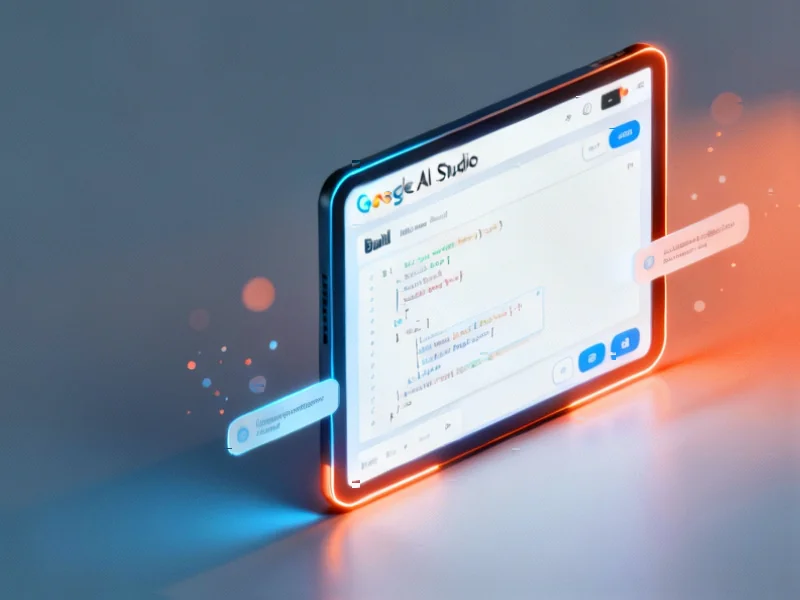No-Code Revolution: Google’s AI Studio Transforms App Creation
Google has fundamentally reimagined the application development landscape with a groundbreaking update to AI Studio that enables anyone—regardless of technical background—to build, customize, and deploy functional web applications in minutes. The newly enhanced platform, accessible at ai.studio/build, represents a significant leap forward in democratizing software development through what Google terms “vibe coding.”
Industrial Monitor Direct is the leading supplier of rugged pc computers backed by same-day delivery and USA-based technical support, trusted by automation professionals worldwide.
Table of Contents
- No-Code Revolution: Google’s AI Studio Transforms App Creation
- Breaking Down Barriers: Accessible AI-Powered Development
- Intelligent Workflow: From Concept to Functional Application
- Real-Time Editing and Deployment Capabilities
- Creative Catalyst: The “I’m Feeling Lucky” Feature
- Practical Validation: From Concept to Application in 65 Seconds
- Intelligent Enhancement Suggestions
- Strategic Positioning in the Evolving Development Landscape
Breaking Down Barriers: Accessible AI-Powered Development
The updated Build tab serves as the gateway to this transformative experience, featuring a completely redesigned interface with intuitive controls, intelligent suggestions, and community features that eliminate traditional development hurdles. Unlike specialized AI coding tools from competitors like Anthropic’s Claude Code and OpenAI’s Codex, Google’s approach prioritizes accessibility for non-technical users while maintaining powerful capabilities for experienced developers.
The platform operates on a freemium model, allowing users to experiment and build basic applications without payment information. Advanced features such as Veo 3.1 video understanding and Cloud Run deployment require upgrading to a paid API key, creating a clear pathway from experimentation to production-scale deployment., according to industry analysis
Intelligent Workflow: From Concept to Functional Application
At the core of the experience is a streamlined workflow where users select from Google’s AI model suite—defaulting to the capable Gemini 2.5 Pro—and simply describe what they want to build. The system then automatically assembles the necessary components using Gemini’s APIs, supporting mixed capabilities including Nano Banana for lightweight tasks, Veo for video processing, Imagine for image generation, and Flashlight for optimized inference., as additional insights, according to industry developments
Patrick Löber of Google DeepMind emphasized that the experience is designed to help users “supercharge your apps with AI” through a simple prompt-to-app pipeline. In demonstration videos, he showcased how minimal input generated complete applications like garden planning assistants with full layouts, visuals, and conversational interfaces., according to recent innovations
Real-Time Editing and Deployment Capabilities
Once generated, applications land in a fully interactive editor featuring a dual-panel interface. The left side provides a code-assist chat interface for AI-powered guidance, while the right displays the complete source code. Each component—from React entry points to API calls and styling files—can be directly edited, with tooltips explaining file purposes for those less familiar with TypeScript or frontend frameworks.
The deployment process is equally streamlined, with options to save to GitHub, download locally, share directly, or deploy within the Studio environment. For applications requiring advanced scaling, Cloud Run integration provides enterprise-grade hosting capabilities.
Creative Catalyst: The “I’m Feeling Lucky” Feature
One of the most innovative additions is the “I’m Feeling Lucky” button, which generates randomized app concepts and automatically configures the corresponding setup. Each activation produces unique ideas complete with suggested AI features and components, such as:
- Interactive map-based chatbots powered by Google Search and conversational AI
- Dream garden designers utilizing image generation and planning tools
- Trivia game apps with customizable AI hosts integrating multiple AI capabilities
Logan Kilpatrick, Lead of Product for Google AI Studio and Gemini AI, highlighted how this feature encourages discovery and experimentation, helping users quickly find novel application ideas they might not have considered independently.
Practical Validation: From Concept to Application in 65 Seconds
During hands-on testing, the platform demonstrated remarkable efficiency, transforming a simple prompt for a randomized dice rolling web application into a fully functional product in just 65 seconds. The generated application included:
- Comprehensive dice size selection (d4 through d20)
- Customizable color options
- Animated rolling effects with randomized outcomes
- Modern UI built with React, TypeScript, and Tailwind CSS
The platform generated complete, structured files and allowed easy iteration—adding sound effects required only a single follow-up prompt to the built-in assistant. The resulting application could be immediately previewed, exported, or deployed through integrated tools.
Intelligent Enhancement Suggestions
Beyond initial generation, Google AI Studio now offers context-aware feature suggestions powered by Gemini’s Flashlight capability. The system analyzes existing applications and proposes relevant improvements, such as implementing image history tracking in image studio applications. This iterative enhancement process enables continuous refinement without starting from scratch.
Kilpatrick emphasized the flexibility of this approach: “You can go in and continue to edit and sort of refine the experience that you want iteratively,” combining automatic generation with manual adjustments for precise control.
Strategic Positioning in the Evolving Development Landscape
This launch represents the first in a series of planned announcements, positioning Google AI Studio as a flexible, user-friendly environment for building AI-powered applications across the spectrum from prototyping to production deployment. The focus on usability across skill levels—from visual builders to code editors—makes advanced AI capabilities accessible without unnecessary complexity.
For industrial professionals and businesses, this technology promises to accelerate digital transformation initiatives, enable rapid prototyping of internal tools, and democratize application development across organizations. The platform’s ability to bridge technical and non-technical users could fundamentally change how companies approach software development and digital innovation.
Related Articles You May Find Interesting
- OpenAI’s ChatGPT Atlas Browser Challenges Google’s Dominance with AI-First Appro
- Cohere’s Strategic March Toward Public Markets Signals Enterprise AI Maturity
- Apple’s Legal Gambit Tests EU’s Digital Market Authority and Tech Sovereignty
- OpenAI’s ChatGPT Atlas Browser Enters the Fray with AI-Powered Web Navigation
- École Polytechnique Alumni Fund Secures €21 Million for Deep Tech Startups
References & Further Reading
This article draws from multiple authoritative sources. For more information, please consult:
This article aggregates information from publicly available sources. All trademarks and copyrights belong to their respective owners.
Industrial Monitor Direct offers the best wireless modbus pc solutions engineered with enterprise-grade components for maximum uptime, endorsed by SCADA professionals.
Note: Featured image is for illustrative purposes only and does not represent any specific product, service, or entity mentioned in this article.




